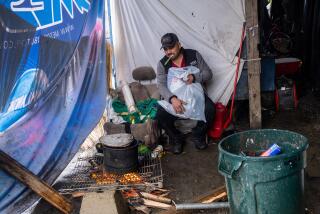Reverting to Pioneer Concept : Warm-Room Plan Helps Poor Weather the Cold
- Share via
ST. LOUIS — The gas company cut off service to Nelda Anderson’s house for non-payment in April of 1983, so when a cruel cold spell fastened its grip on St. Louis the following winter, her 2-year-old granddaughter and 4-year-old grandson, who live with her, suffered severe frostbite.
Bitter weather has descended on the city again this winter--temperatures in the last week have not gone above freezing. But now Nelda Anderson and her grandchildren, and more than 200 other low-income families here, are keeping warm and comfortable, thanks to a pioneering effort to provide the poor and the elderly with affordable heat.
Here, as in a handful of places across America, community groups and utilities are reviving the hearth rooms of old--giving those who cannot pay a warm refuge in extreme weather by selectively heating only portions of homes.
“It reverts back to pioneer days, when everybody stayed by the fire,” Bob Griffin, residential manager for the Edison Electric Institute in Washington, said of the “warm room” concept. “It’s going to catch on like wildfire, ‘cause it makes sense.”
In St. Louis, Union Electric Co. has pooled its funds with those of three public agencies to help finance the extensive insulation of one room in more than 250 residences. Those rooms are heated with electric space heaters while the remainder of the house remains cool. The program, now in its third winter, is a welcome development in neighborhoods of aging and run-down housing.
“I can close those doors, turn on the heater and be nice and warm,” said Eddie Jones, 44, the mother of four, who got a warm room in December. Her walk-up apartment on St. Ferdinand Street is next to a wind-whipped abandoned apartment with no windows. Her gas bill used to consume more than $90 of her $349 monthly check in Aid to Families with Dependent Children.
“It was just taking all of my money to heat,” she said. “It was terrible. It wouldn’t get warm in here at all. Air was coming through the cracks.”
She is now awaiting her first gas bill since her living room was insulated.
But for many, the question is not just saving money. “It approaches survival . . . for the most vulnerable of our citizens,” said Greg Echele, a social worker with St. Louis Children’s Hospital, which each year treats scores of weather-related injuries and illnesses among young persons.
Aid for Elderly
The warm-room concept is the latest in a series of efforts to help the elderly and the poor with towering heating costs. In recent years, growing numbers of gas and electric companies--and their customers--have given money to charities to help low-income families pay their utility bills and avoid life-threatening shut-offs of service.
But the warm-room approach is seen as a more enduring solution than annual subsidies to the needy from charities or federal energy programs. “The problem is, you’ll be doing that forever, and their bills will get higher,” Union Electric’s vice president for customer service, Harry E. Wuertenbaecher Jr., said of such subsidies. “So any meaningful program is a weatherization program.
“Ideally, you could do the whole house (with insulation), but that’s too expensive.”
$1,100 Cost
The average cost of making a single room--usually a living room or bedroom--into a warm refuge is about $1,100. The work involves:
--Installing Styrofoam sheeting on the exterior walls of one room, covering this insulation with dry wall and taping plastic sheeting over windows.
--Lowering the ceiling to about seven feet or so and insulating it, and installing a door to prevent heat loss.
--Providing a $20 electric space heater.
“We’re not recommending that people spend their entire life in one room,” said Wuertenbaecher. “But in this extreme weather, it’s ideal.”
Union Electric began its program in the fall of 1982 with a $50,000 gift to the United Way, which contracted with a nonprofit housing rehabilitation agency, Senior Home Security, to install warm rooms in the homes of the elderly and the handicapped.
Help for Children
The power company gave another $50,000 last winter, and the Missouri Housing Development Council added $50,000 in response to the frostbite incident involving Nelda Anderson’s grandchildren. This grant extended the warm-room program to homes with children, and 93 of 155 warm rooms installed last year were to benefit the young.
This year, Union Electric and three public agencies have put $248,000 into the warm-room program. To be eligible, a family must be receiving public assistance. The local office of the state Division of Family Services determines who gets warm rooms.
“We will reach our goal of 250 (new warm rooms) this year, “and there will still be more people in line wanting them,” John Vincenzo, executive director of Senior Home Security, said of those needing help.
In a happy sidelight, Senior Home Security took nine men and women off welfare and unemployment rolls, trained them and now pays them $5.50 an hour to do the actual warm-room construction. Seven others trained in the program have gotten jobs elsewhere.
Affluent May Follow
Wuertenbaecher thinks more affluent families will also adopt the plan to reduce fuel bills.
“We’re going to crowd up in the front room,” Angela Najieb, 27, said of the warm room being installed in her walk-up apartment. With broken windows, cracks and no insulation in her rented home, she lost gas service last August after running up a $1,469.29 bill she could not pay. Service was restored Nov. 2 on the condition that she make $182.75 monthly payments--from the $378 she and her mother receive each month. She has three children, ages 9, 4 and 2.
“We turn the thermostat up to 80 degrees and keep the oven on,” she said. “But we have so many air holes, it’s still really cold.
“That was the coldest room of the house,” she said of the room that will soon be the warmest. “I’m looking forward to this.”
More to Read
Sign up for Essential California
The most important California stories and recommendations in your inbox every morning.
You may occasionally receive promotional content from the Los Angeles Times.









